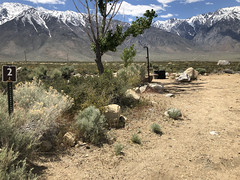BLM Bishop Field Office issues seasonal fire restrictions
Organization:
BLM Office:
Media Contact:
 BISHOP, Calif. – The Bureau of Land Management Bishop Field Office has issued seasonal fire restrictions for BLM-managed public lands in the Eastern Sierra effective Monday, July 1, due to increased wildland fire danger in the region. The restrictions will remain in effect until November 1, or until wildland fire conditions on public lands in the region improve.
BISHOP, Calif. – The Bureau of Land Management Bishop Field Office has issued seasonal fire restrictions for BLM-managed public lands in the Eastern Sierra effective Monday, July 1, due to increased wildland fire danger in the region. The restrictions will remain in effect until November 1, or until wildland fire conditions on public lands in the region improve.
Fire officials estimate that nearly 90 percent of wildland fires affecting BLM-managed public lands in California during the last decade have been human caused. Individuals who spark wildfires, intentionally or unintentionally, may be held responsible for fire suppression and property damage costs. Officials encourage the public to be extremely careful when recreating outdoors, to carry a shovel and water at all times, and to check weather forecasts and fire danger conditions before leaving home.
The following restrictions will remain in place until the risk of wildland fire in the Eastern Sierra subsides:
- No campfires, charcoal or wood barbeques, or similar open flame fires, except within a designated campsite with a fire ring or fire pit specifically provided for such use in the following developed campgrounds: Tuttle Creek Campground, Goodale Creek Campground, Horton Creek Campground, Crowley Lake Campground and Pleasant Valley Pit Campground. Portable stoves burning gas, jelled petroleum or pressurized liquid fuel are allowed outside of developed campgrounds when used in accordance with a valid California Campfire Permit, available free at all BLM, Forest Service and Cal Fire offices or at www.preventwildfireca.org/Permits.
- No tools powered by internal combustion engines off established roads, trails or parking areas (such as chainsaws or lawn mowers).
- No smoking, except within an enclosed vehicle or building, or within the developed campgrounds listed above, or while stopped within an area at least five feet in diameter that is barren or cleared of all flammable materials.
- No motorized vehicles off established roads, trails or parking areas.
- Target shooters may not use incendiary, exploding, tracer, steel core or armor piercing ammunition. Shooting at steel or exploding targets that could emit sparks is not allowed. Target shooters must have a shovel or fire extinguisher on hand. Hunters may use steel shot and other non-lead ammunition as required by California State Law.
- No fireworks, including “safe and sane” fireworks.
- No welding or operating an acetylene or other torch with open flame, except by special permit.
- No use of explosives, except by special permit.
BLM-managed public lands subject to these fire restrictions extend from the southern Owens Valley in Inyo County, north to Topaz Lake and the Nevada border in Mono County. These fire restrictions also apply to popular BLM-managed recreational areas in the region including the Alabama Hills National Scenic Area, Inyo Mountains Wilderness, Volcanic Tableland, Long Valley, Adobe Valley, Mono Basin, Bodie Hills and Slinkard Valley. BLM seasonal fire restrictions for the Eastern Sierra Region are being implemented in close coordination with Cal Fire (https://www.facebook.com/1663811310523258/posts/2419842918253423?sfns=mo).
The BLM is committed to keeping public landscapes healthy and productive by working closely with cooperating agencies, neighboring communities, and public land visitors to prevent wildland fires. To learn how you can do your part to prevent wildland fires visit www.readyforwildfire.org. A listing of fire restrictions throughout BLM California is available at https://go.usa.gov/xmUEG. For specific questions, please contact the Bishop Field Office at 760-872-5000.
The BLM manages about 245 million acres of public land located primarily in 12 western states, including Alaska, on behalf of the American people. The BLM also administers 700 million acres of sub-surface mineral estate throughout the nation. Our mission is to sustain the health, diversity, and productivity of America’s public lands for the use and enjoyment of present and future generations.
